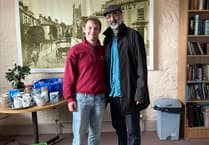New Dartmouth Town Councillor Mike Rowley is hoping to put the town’s Newcomen engine – on permanent display next to the visitor centre - more firmly on the map.
Having recently joined the town council, and also the Dartmouth Friends of Newcomen group, Cllr Rowley is keen to raise the steam engine’s profile, including more links with the museum and a possible steam festival in the town.
He said: “It’s place in industrial history is seminal. It literally kicked off the Industrial Revolution in Britain and across the world. It’s a big asset of Dartmouth and we really ought to make more of it.
“We only know of two full engines remaining – one in Dudley in the Black Country Living Museum and this one in Dartmouth.
“Deputy Mayor Graham Evans is also enthusiastic about the engine, and we’ve been bouncing a few ideas around between us. We think there could be scope for a possible steam festival in Dartmouth, as we have the Newcomen Engine, Kingswear Castle Paddle Steamer and the steam railway at Kingswear.”
Dartmouth’s engine was designed by Thomas Newcomen (1664-1729), as one of the first successful steam engines in the world. It was used initially for pumping water out of coal mines. More than 2000 Newcomen engines were installed world-wide during the 18th and 19th centuries, over 600 of them before 1775 when James Watt was able to improve their efficiency.
Thomas Newcomen was born in Foss Street, Dartmouth. He was an ironmonger and blacksmith. He later leased a house and workshop in Higher Street, where he started to experiment with the steam engine that would change the world.
The engine on display next to the visitor centre was moved to Dartmouth in 1963 by the Newcomen Society for demonstration in the inventor’s hometown. The engine has a simple untrussed wooden beam with arch heads, chain connections and a hydraulic device now operates the venerable engine at low speed. The operating valves are activated by a plug rod as in early engines. It’s surveyed annually to keep it well maintained.
Cllr Rowley’s interest in the engine mirrors his background in heavy mechanical engineering, including work as a night shift charge engineer at Lea Hall Colliery in Staffordshire during the 1980s.
He said: “Working in a coal mine has its moments, but you get used to it. There were some scary times, including once when one of the old guys saved my life – he hit the emergency stop button, grabbed me by the scruff of the neck and dragged me out just before 120-foot of rock came down. He sensed a fault before any of us were aware. The old guys who’d worked at the coal face before heavy machinery had a second sense down there.
“I worked for British Coal for 14 years and loved it, although there were some interesting times during the miners’ strike in the 80s!”
Mike took voluntary redundancy and moved from Nottingham to Dartmouth in 1988, with his wife Penny and family. They followed their passion for SCUBA diving by owning and operating a diving charter vessel from Dartmouth.
He added: “We’ve now been in Dartmouth longer than we’ve been anywhere – and I’m just about diving still!
“Dartmouth is wonderful – if someone had said to me during the miners’ strike I’d be living down here like this I’d have thought they were mad. We’re so happy to be here.”
Mike is also a volunteer at Dartmouth Museum and is keen to see the museum working more closely with the Newcomen engine, promoting its status as part of our industrial heritage.




